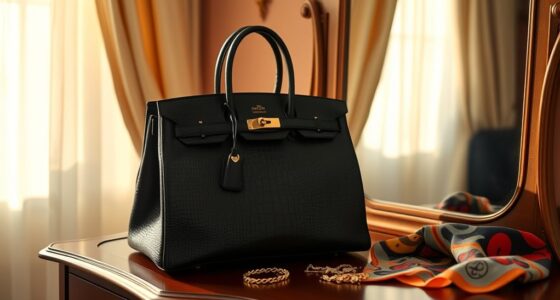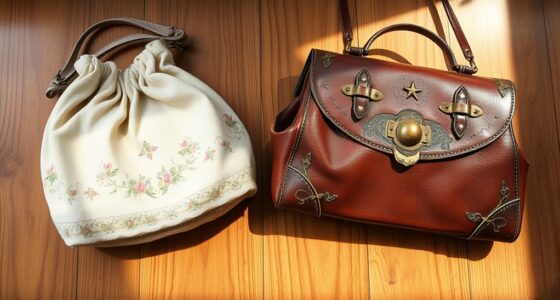The “It bag” phenomenon of the 2000s grew from savvy branding, celebrity influence, and exclusivity marketing. You saw how luxury brands used limited editions and scarcity to create hype. Celebrities and social media made these bags status symbols, while media coverage boosted their desirability. Iconic designs like the Hermès Birkin became cultural icons. If you want to understand how these bags transformed fashion and society, there’s much more to uncover.
Key Takeaways
- The “It Bag” trend originated in the early 2000s, emphasizing exclusivity, craftsmanship, and status symbolism.
- Celebrities and media amplified their desirability through endorsements and coverage, transforming bags into cultural icons.
- Luxury brands used scarcity marketing and limited editions to create urgency and elevate perceived value.
- The phenomenon reflected societal shifts towards branding, social capital, and self-expression through fashion.
- Its legacy endures through vintage collections, sustainable practices, and the evolution of luxury as a status symbol.
The Origins of the “It Bag” Concept
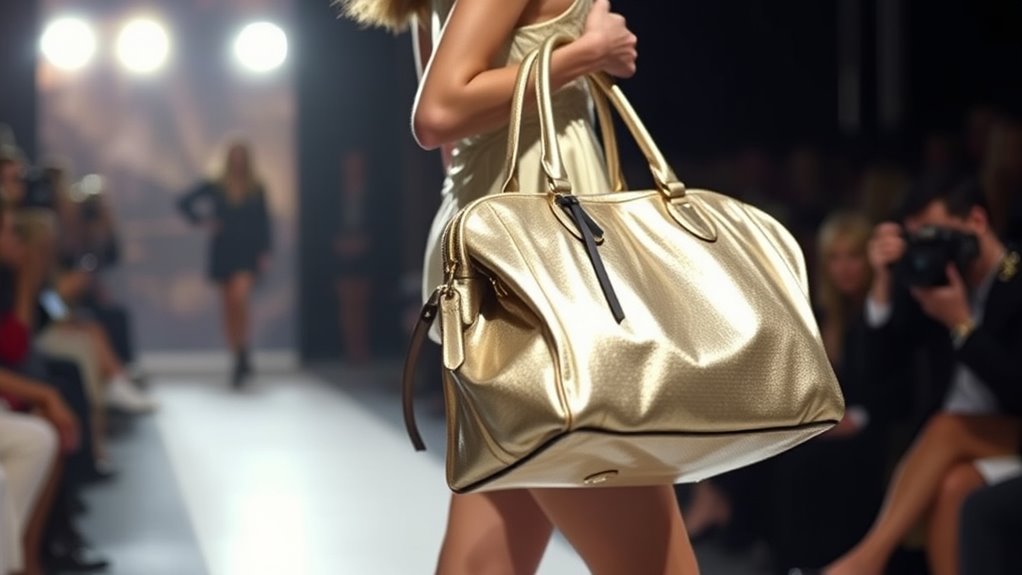
The concept of the “It Bag” emerged in the early 2000s as a symbol of status and style, capturing the attention of fashion enthusiasts worldwide. Its rise can be traced to an increased focus on handbag craftsmanship, where brands began emphasizing quality, design, and exclusivity. Trend forecasting played a pivotal role, as designers and marketers predicted which styles would resonate with consumers and become must-have pieces. These bags weren’t just accessories; they became cultural symbols, representing sophistication and social standing. Limited editions and innovative designs fueled demand, making the “It Bag” a coveted item. As the fashion landscape evolved, brands carefully curated their collections to stay ahead of trends, ensuring that their bags would capture the imagination of the style-conscious and solidify their status as icons. Additionally, the allure of a recognizable, iconic design contributed significantly to their popularity and desirability.
The Role of Celebrity Endorsements and Influencers
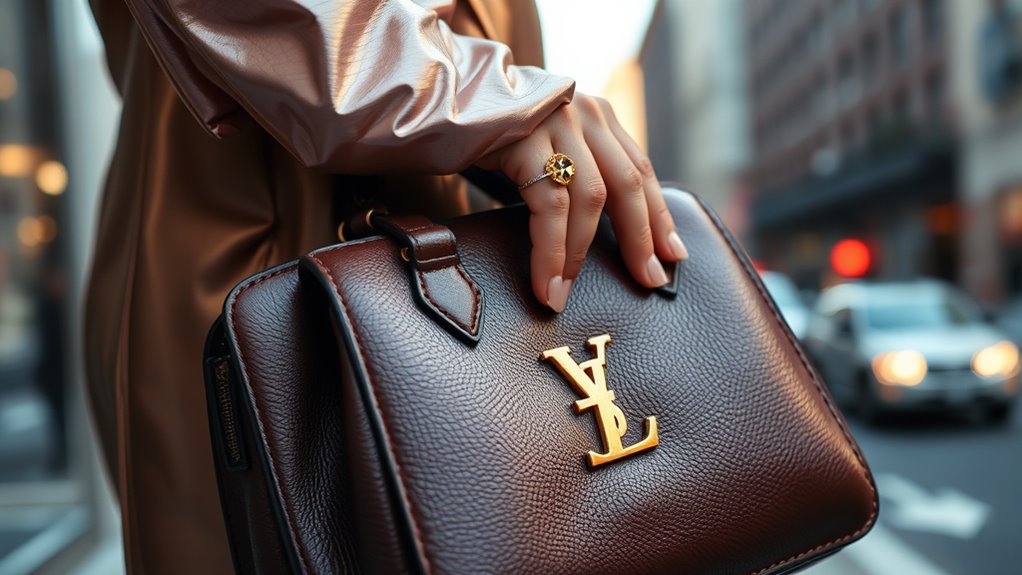
Celebrity endorsements and influencers played a pivotal role in fueling the popularity of “It Bags” during the 2000s. They elevated luxury branding by showcasing these bags as symbols of status and style, making them highly desirable. When celebrities flaunted their designer bags in magazines, on red carpets, or through social media, it sparked instant trends among fans keen to emulate their icons. Influencers, emerging as new tastemakers, further pushed fashion innovation by introducing fresh ways to style and showcase “It Bags.” Their reach transformed these bags from exclusive luxury items into must-have accessories accessible to a wider audience. This dynamic created a buzz that not only boosted sales but also cemented the “It Bag” as an essential element of contemporary fashion culture. Additionally, the influence of celebrity endorsements helped to sustain the bags’ status as coveted objects of desire.
Marketing Masterstrokes and Limited Editions
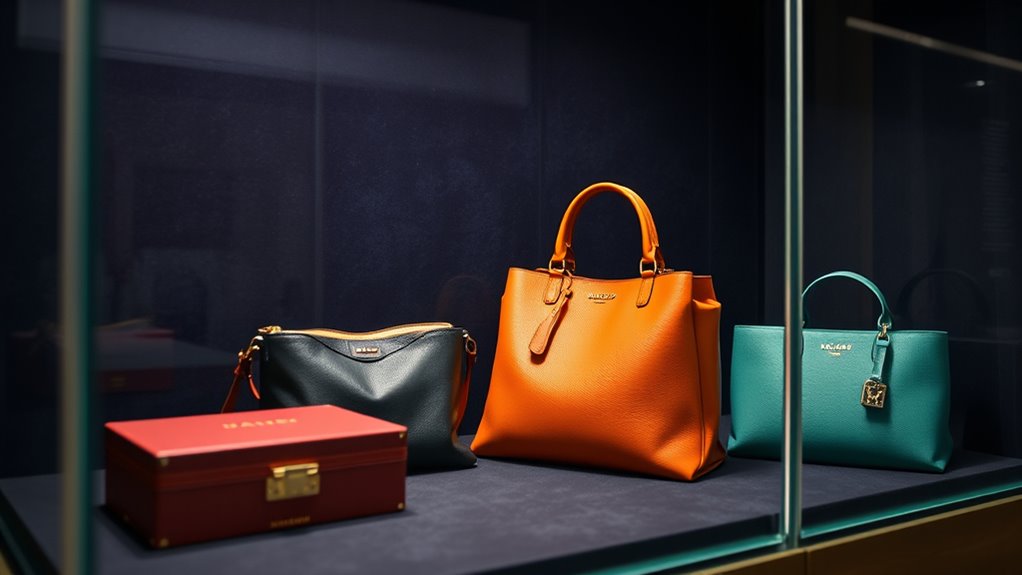
Innovative marketing strategies and limited-edition releases transformed how “It Bags” captured public attention during the 2000s. Brands used clever branding strategies to create exclusivity and desirability, tapping into consumer psychology that craves uniqueness. Limited editions, often released in small quantities, heightened perceived value and urgency, encouraging quick purchases. Social proof played a key role—when celebrities or influencers flaunted these bags, it reinforced their status as must-have items. Scarcity marketing made the bags seem more special, fueling demand among trendsetters enthusiastic to stand out. By combining strategic branding with limited availability, brands successfully cultivated allure and anticipation around “It Bags,” turning them into essential symbols of status and style that defined the era. Additionally, the use of popular apps and social media platforms to showcase these bags further amplified their desirability and created a buzz among fashion enthusiasts.
The Impact of Luxury Brands on the Trend

Luxury brands played a pivotal role in shaping the “It Bag” trend by leveraging their heritage, craftsmanship, and exclusivity to elevate handbag desirability. Through luxury branding, these companies created a sense of prestige that made owning their bags a status symbol. They used exclusivity marketing to generate hype, often limiting availability to boost demand and desirability. By positioning their handbags as rare, luxurious items, these brands made them highly coveted collectibles. This strategy encouraged consumers to see these bags as more than just accessories—they became symbols of success and fashion-forwardness. The combination of heritage storytelling, selective distribution, and a focus on craftsmanship fueled the trend, turning certain bags into must-have icons that defined the era’s luxury landscape. Additionally, the marketing tactics employed by these brands often involved creating a sense of scarcity, further increasing the bags’ desirability and exclusivity.
Cultural Shifts and the Rise of Luxury Consumption
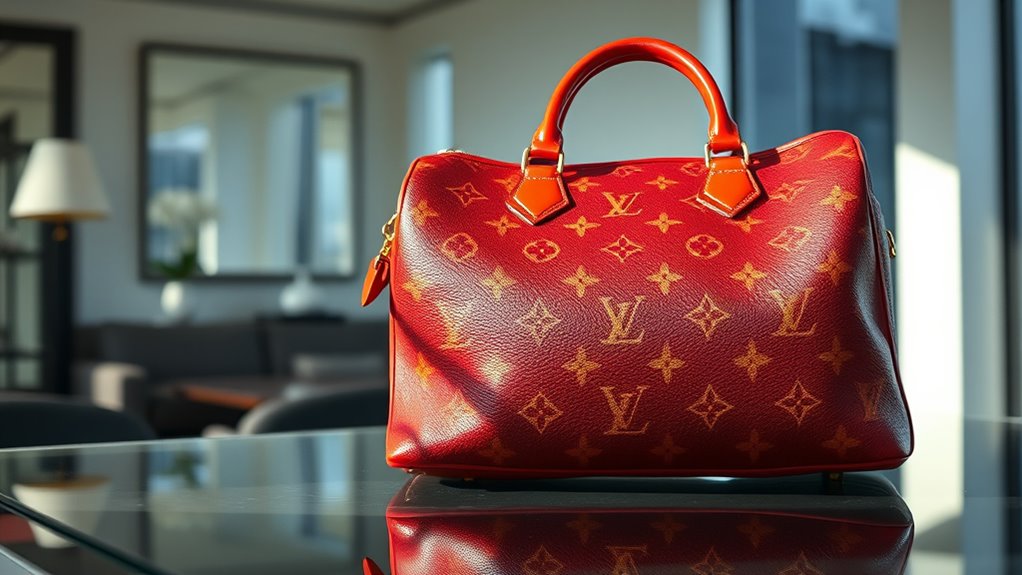
You notice how celebrity endorsements and social media make luxury bags highly desirable, shaping what’s fashionable in real time. As luxury becomes a form of cultural capital, owning these items signals status and identity to others. This shift reflects a broader change in society’s values, where image and influence take center stage. Additionally, the phenomenon of the “It Bag” was amplified by brand marketing strategies, which capitalized on exclusivity and aspirational branding to drive demand.
Celebrity Endorsements Amplify Desire
Celebrity endorsements played a pivotal role in fueling the desire for “It Bags” during the 2000s, as they transformed these accessories from mere fashion statements into symbols of status and aspiration. Celebrity influence became a powerful marketing tool, with stars often seen carrying or wearing luxury bags, making them highly coveted. Brand collaborations with celebrities further amplified this effect, creating a direct link between celebrity culture and luxury consumption. When a famous personality was associated with a particular bag, it instantly elevated its desirability, encouraging fans to emulate their style. This synergy between celebrities and brands drove demand and solidified the “It Bag” as a must-have item. As a result, luxury handbags transitioned from exclusive possessions to cultural icons, driven by fame and strategic partnerships. Celebrity endorsements transformed the landscape of fashion marketing, making these bags symbols of cultural relevance.
Social Media’s Trendsetting Power
As social media platforms gained prominence in the 2000s, they transformed the way trends spread and influence consumer behavior. Digital influence became a powerful tool, allowing you to see what influencers and peers wear or use in real time. This instant access accelerates the popularity of specific brands and styles, making it easier for you to follow and adopt trends quickly. You’re no longer dependent solely on traditional media; instead, social media shapes your perceptions of desirability and status. As a result, consumer behavior shifts toward seeking instant gratification and exclusivity, fueling the rise of luxury consumption. The platforms amplify the reach of the “It Bag” phenomenon, turning ordinary accessories into symbols of social currency in a matter of hours. Additionally, the impact of Personality Tests can influence consumer preferences and self-image, further fueling trend adoption.
Luxury as Cultural Capital
Social media’s rapid spread of trends not only influenced what you wear but also reshaped how luxury functions within society. Now, luxury isn’t just about exclusivity; it’s about cultural symbolism and status. Luxury branding has become a way to communicate identity and social positioning. You see this shift in how luxury items symbolize more than wealth—they reflect cultural values and aspirations.
| Luxury as Cultural Capital | Significance |
|---|---|
| Cultural Symbolism | Embodying societal values and trends |
| Luxury Branding | Communicating status and identity |
| Cultural Shifts | Redefining luxury’s role in society |
This evolution elevates luxury from mere materialism to a form of cultural capital, shaping how you express yourself and connect with others.
The Psychology of Scarcity and Desire
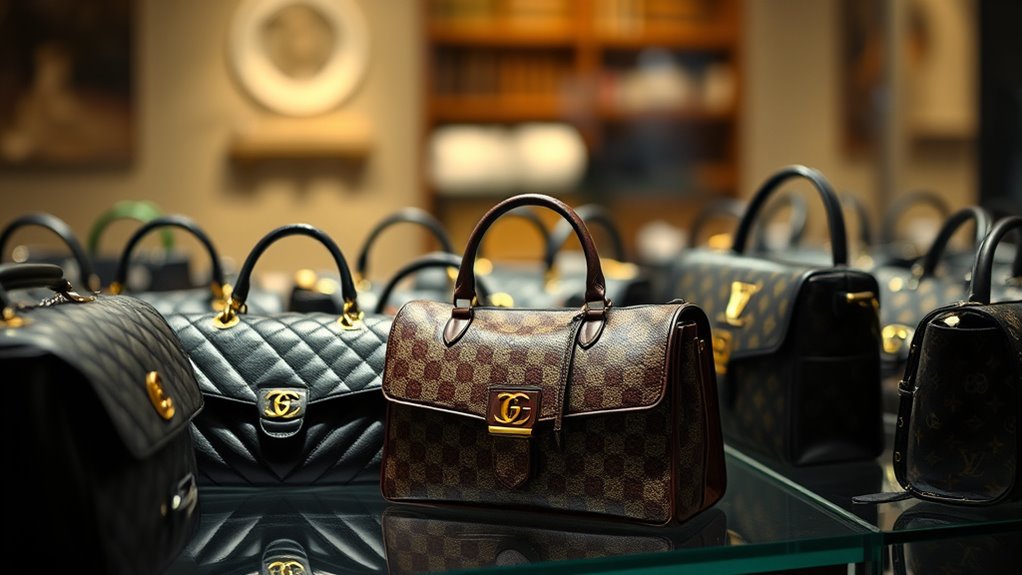
The psychology of scarcity and desire reveals why limited-edition “It Bags” created such intense demand. When you see something rare, psychological triggers activate your consumer psychology, making you value it more. Scarcity creates a sense of urgency—if a bag is hard to find, you believe it’s more exclusive and desirable. This feeling taps into your innate need for uniqueness and status, driving you to act quickly. Limited availability triggers a fear of missing out, intensifying your desire to own the item before it’s gone. As a result, the scarcity amplifies the perceived value, pushing you to prioritize acquiring the bag over other options. Understanding these psychological triggers helps explain why “It Bags” became symbols of aspiration and social capital during the 2000s.
Iconic “It Bags” That Defined an Era
During the height of the “It Bag” craze in the 2000s, certain designs captured global attention and became symbols of style and status. The Hermès Birkin, with its exclusivity and craftsmanship, was a must-have for bag collecting enthusiasts, representing luxury at its finest. The Louis Vuitton Speedy, often seen in celebrity hands, became a versatile icon of casual elegance. Designer collaborations also fueled hype; for example, the Fendi Baguette gained popularity after its appearance on influential TV shows. These bags weren’t just accessories—they were status symbols that defined a generation. As collectors sought rare editions and limited releases, the “It Bag” phenomenon solidified its place in fashion history, inspiring a new wave of obsession with designer collaborations and collectible handbags.
The Influence of Media and Fashion Press
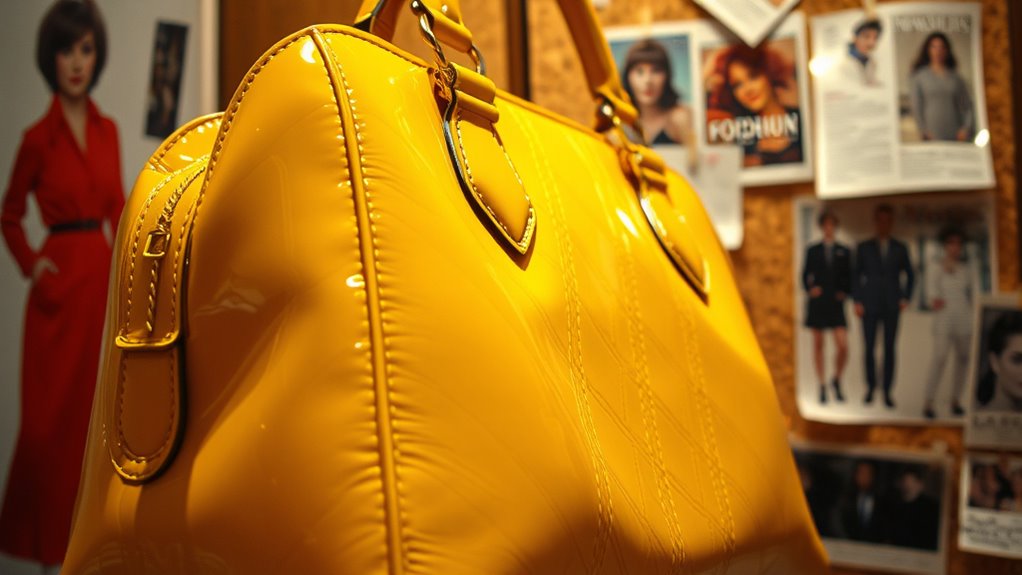
Media outlets and fashion publications played a crucial role in amplifying the hype surrounding “It Bags” in the 2000s. They shaped fashion iconography by featuring these bags prominently in editorials, making them symbols of status and style. Magazines and blogs told compelling brand stories, turning designers into household names and giving each bag a unique identity. As a result, the media created a buzz that fueled demand and desire, often showcasing celebrities carrying these coveted accessories. This coverage didn’t just highlight the bags; it elevated their cultural significance. You saw how media exposure transformed a simple accessory into a must-have item, reinforcing the idea that owning an “It Bag” signified not just fashion sense but also social standing.
The Legacy and Evolution of the “It Bag” Culture
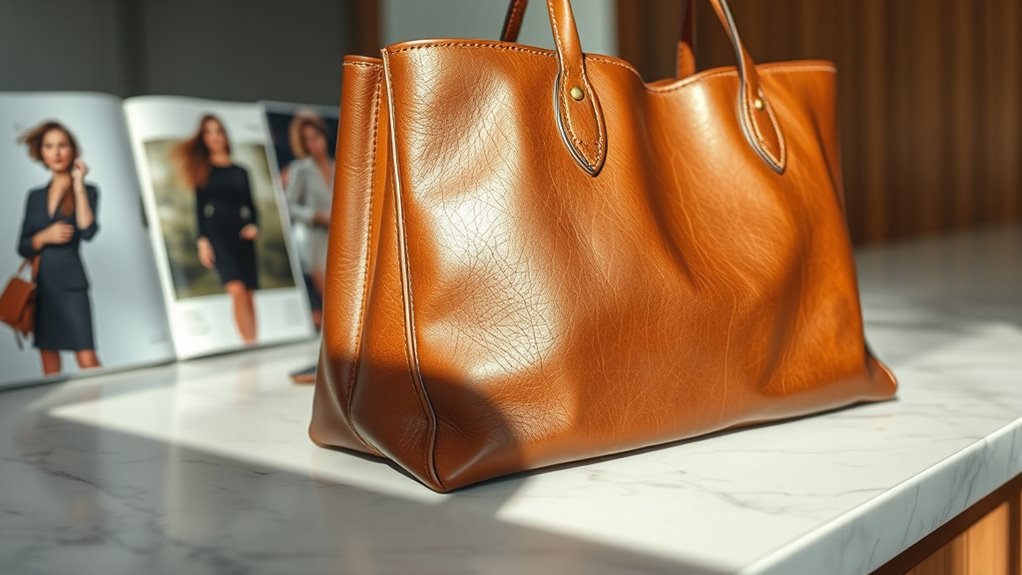
Although the hype around “It Bags” of the 2000s has cooled, their influence still shapes fashion today. You now see a vintage revival, where pre-loved bags gain new life, blending history with modern style. The “It Bag” culture has evolved into a focus on sustainable luxury, emphasizing quality over quantity. Today’s consumers value timeless pieces, investing in bags that last. This shift encourages brands to prioritize eco-friendly practices and responsible sourcing. The legacy of “It Bags” is clear: they transformed from fleeting trends into symbols of status, now intertwined with sustainability.
| Vintage Revival | Sustainable Luxury |
|---|---|
| Resurgence of classic styles | Eco-conscious brand practices |
| Thrifted and secondhand finds | Durable, high-quality materials |
| Limited editions or reissues | Ethical production methods |
| Nostalgic value | Long-term investment mindset |
Frequently Asked Questions
How Did the “It Bag” Trend Influence Everyday Consumer Behavior?
You saw the “it bag” trend influence your everyday choices by fueling your luxury aspirations. It made you crave exclusive, recognizable pieces that signal status and style. This trend encouraged you to prioritize consumer exclusivity, often saving or splurging to own a coveted designer bag. It shifted your focus from practicality to owning a symbol of fashion prestige, shaping your buying habits around the idea that owning an “it bag” defines your personal style and social standing.
Were There Regional Differences in the Adoption of “It Bags”?
Imagine a tapestry woven with vibrant regional threads; your adoption of “it bags” reflects this diversity. Regional preferences and cultural influences shape how you embrace these trends, making each area’s style unique. In some places, luxury and status are the heartbeat of fashion, while others prioritize practicality or tradition. These differences create a colorful mosaic, showing that your fashion choices are deeply rooted in local customs and cultural nuances.
What Role Did Social Media Play in the Rise of “It Bags”?
Social media played a huge role in the rise of “it bags” by fueling viral marketing and boosting influencer collaborations. You see, when influencers showcase these bags, they instantly become desirable and trendy. The instant sharing and viral nature of social media make it easy for “it bags” to gain global attention quickly, turning them into must-have items. This digital buzz accelerates their popularity and solidifies their status as icons of luxury fashion.
How Have “It Bags” Impacted the Pricing Strategies of Luxury Brands?
You might notice that “it bags” have pushed luxury brands to adjust their pricing strategies. They leverage branding strategies centered on exclusivity marketing, making the bags more desirable and rare. This approach allows brands to set higher prices, reinforcing the status symbol. As a result, the perceived value skyrockets, and consumers are willing to pay a premium, fueling the “it bag” phenomenon even further.
Are “It Bags” Still Relevant in Today’S Fashion Landscape?
You might wonder if “it bags” still matter today. They’re definitely still pertinent, thanks to the vintage revival and celebrity endorsements that keep them in the spotlight. You’ll notice many people seek classic styles with a modern twist, and celebrities often showcase these bags on social media. This blend of nostalgia and star power ensures “it bags” continue influencing fashion trends and consumer preferences.
Conclusion
As you reflect on the “It Bag” phenomenon, imagine a shimmering beacon guiding your desire through the crowded runway of fashion trends. These bags weren’t just accessories—they became symbols of aspiration, weaving a tapestry of culture, celebrity, and scarcity. In this world of fleeting moments, the legacy endures, whispering that true style is a dance between longing and possession, forever echoing in the gallery of fashion history.

